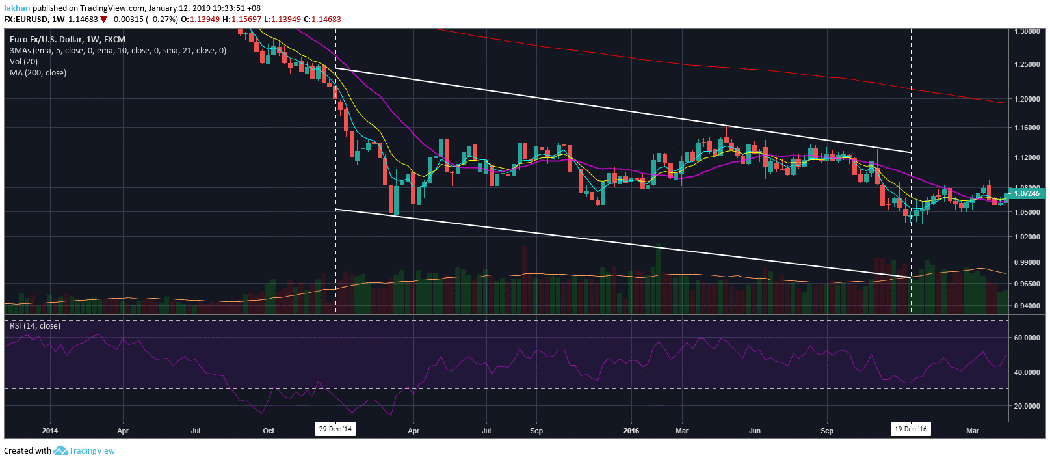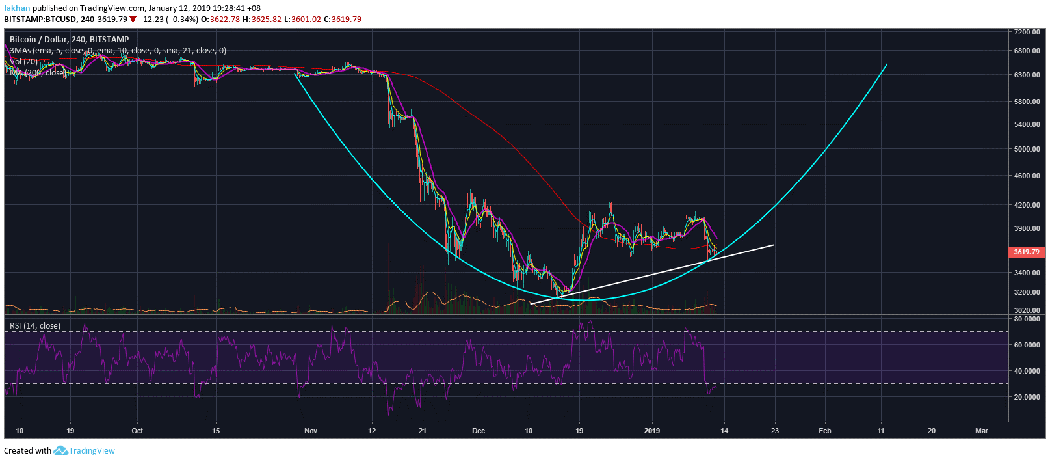The recent yearlong correction has convinced most investors and analysts that Bitcoin (BTC) is repeating the exact same cycle as before. It is true that Bitcoin (BTC) did decline in the same manner that it did in 2014-15 for the most part, but that does not mean that whatever followed afterwards is also going to repeat this time. Whenever Bitcoin (BTC) is due for a correction to the downside, it corrects regardless of the movement of bigger related markets. For instance, Bitcoin (BTC) started to fall in January, 2018 whereas EUR/USD kept on rising till March, 2018 when it finally topped out and started to decline. However, the converse is not true. If Bitcoin (BTC) is due for a correction to the upside, it waits for bigger markets to support its move.
As Bitcoin (BTC) is traded predominantly in US Dollar (USD), its movements depend largely on the movement of EUR/USD during a bull market or at critical turning points. After the bear trend of 2014-15, Bitcoin (BTC) took almost two years to reach its previous all-time high. There are certain reasons why it took that long. First of all, the market cap of Bitcoin (BTC) was just $4 billion! After the Mt. Gox hack, there was a good chance that all of this could have been a failed experiment and Bitcoin (BTC) would have been dead. It was a new technology and even the early developers did not know if Bitcoin (BTC) would be able to reach the level of adoption it has today. The media was very hard on Bitcoin (BTC) and the sort of flash crashes we had back then would surprise most traders today.

Bitcoin (BTC) was part of a tiny emerging market that had a good chance of failing. Strong regulation early on could have effectively put an end to cryptocurrencies or at least hurt their prospects for a long time. All of these issues were major risk factors for investors but Bitcoin (BTC) might still have recovered faster if EUR/USD had been trading under favorable conditions. When Bitcoin (BTC) bottomed out in December, 2014, EUR/USD was in a decline. That decline did not stop for the next two years which explains why Bitcoin (BTC) had been trading sideways. A lot of people like to compare Bitcoin (BTC) with Gold but they forget that Gold is a trillion dollars market that has existed for a long time. Bitcoin (BTC) on the other hand was nothing more than a highly speculative asset back then.
Even if the sentiment had been in its favor, Bitcoin (BTC) might have found it quite difficult to rally when the EUR/USD was declining between 2015 and 2017. Soon as EUR/USD started to recover in early 2017, so did Bitcoin (BTC) and we saw an aggressive rally that resulted in BTC/USD reaching an all-time high of $19,665 in December that year. Now, this is where it gets interesting. Bitcoin (BTC) has just bottomed out and is now preparing to begin another bullish cycle. However, the EUR/USD outlook this time is not like the one between 2015 and 2017. In fact, it is like the one between 2017 and 2018. So, does this mean that Bitcoin (BTC) could skip big cycles of sideways movement and skyrocket in 2019? Yes, that would appear to be the most probable scenario under current circumstances.

The upcoming major rally in BTC/USD will be just like the one in Gold after 2001. However, the circumstances will be different. While Gold profited off the stock market crisis (dot com bubble), Bitcoin (BTC) is expected to profit off a global currency crisis. The US Dollar is on the verge of collapse. Trump’s government shutdown is now the longest federal shutdown in history. All of these signs are beginning to line up and are pointing to the inevitable that lies ahead. Americans have become too dependent on their credit economy, but what happens when they want to cash out but find out that the numbers displayed on their digital bank accounts cannot be backed by actual cash. This is not new and we have already seen how it turned out during the financial crisis of 2008-09.
The previous financial crisis is nothing compared to what is about to come. For decades, the United States has been applying band aids instead of curing the disease. When all of those band aids come off, they are going to expose some serious problems underneath. According to polls conducted on the subject, most people believe that the next financial crisis is going to strike within the next year or two. They are not going to wait for that crisis to strike and put them on the streets. If they know it is coming, they are going to protect themselves in advance. The best way to do that in this day and age is by exchanging your fiat currency for Bitcoin (BTC) while you can.
Investment Disclaimer









